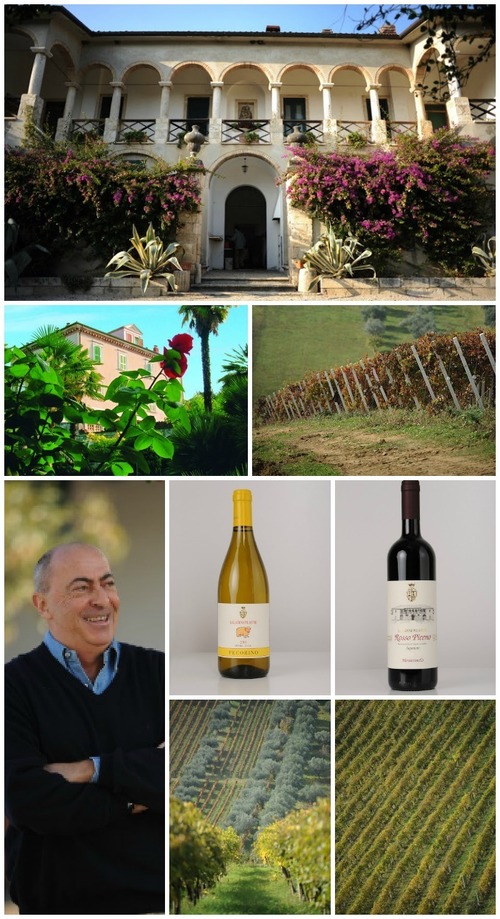See on Scoop.it - Good Things From Italy - Le Cose Buone d’Italia
Next time you’re searching for a unique white wine, uncork a bottle of Saladini Pilastri Pecorino white wine. Is the name of the Italian, family-owned winery a challenge? No problem. Just ask for wine with sheep on the label.
In Italian “pecora” means little sheep. That is why Pecorino wines sport it on the label. But even with a bottle in hand, the image begs the question: What do sheep have to do with this wine? While Pecorino Italian cheese is made from sheep’s milk, that’s only part of this wine’s pedigree.
According to a local legend, the Pecorino grape acquired its name from sheep who loved grazing on Pecorino grapes while shepherded from pasture to pasture. The Greeks brought the grape to Italy, but the low-yielding grape was thought to be extinct until the 1990s.
One reason the sheep may have loved the grapes, which are found in the Marche, Abruzzo, and Umbria wine regions, is for their natural sweetness. Yet Pecorino is not a sweet wine in any sense of the word. It is an aromatic wine with bright acidity that pairs well with all types of seafood dishes.
Saladini Pilastri uses the yellow sheep’s image as a marketing tool, inspiring wine aficionados to explore its organic white wines. The sheep’s image also reflects the white grape’s Denominazione Di Origine Controllata e Garantita (DOCG) required by Italian law.
Pecorino wines must contain at least 85 percent Pecorino grapes to receive the Offida DOCG stamp of approval. Low in acidity, the wine is typically straw-colored and medium-bodied. On the nose, it’s all about nuts and fruits, such as green apple, pineapple, and even bananas.
Count Saladini Pilastri heads up the family wine business from his sprawling villa 2 kilometers from the medieval town of Spinetoli in the Ascoli Piceno province. The lands and titles were gifted to the Saladini Pilastri family 1,000 years ago as a reward for its participation in the Holy Crusades.
Three centuries into it, the Count continues to produce artisan wines and one-of-kind olive oil. The rolling sun-baked hills of Monte Prandone and Porto d’ Ascoli surround the 300 hectares that make up Saladini Pilastri winery.
Nestled in the bucolic Marche appellation in the eastern coastal region of Italy, the winery is not far from the Adriatic Sea. Looking at a map of Italy, the Marche is situated in the “calf” of the iconic Italian boot. In English, the wine region is called the “Italian Marches” region.
Le Marche region, however, is not as famous as neighboring Tuscany and Umbria. But to wine aficionados searching for fine organic wines, that’s a good thing. In fact, Saladini Pilastri implemented low-impact organic farming practices as recently as 1995. Those efforts included eliminating artificial fertilizers and pesticides. By 2008, the winery was one of a few certified organic wineries in Marche.
With celebrated Tuscan enologist and winemaker Alberto Antonini at the helm, Saladin Pilastri was the first winery in the Piceno area to earn the prestigious Tre Bicchieri award from Gambero Rosso, Italy’s wine bible.
The count follows all the process of the harvest, the winery, and the vineyards. He personally controls everything. For him, it is a passion,” said Pietro Piccioni, export manager. “Like the decision to go bio and organic. He started with bio and organic cultivation in 1995, and we wrote “organic” on the first label in 1998.”
The move to organic is one technique that caught the eye of a wine scout from Total Wines & More, which promptly added Saladini Pilastri winery to the company’s portfolio. Now, the fine wines are available at one of TWM’s 80 superstores in 13 states.TWM has stores in New York, New Jersey, and other states on the east coast. A bottle of Pecorino white wine retails for about $10 a bottle.
Although 55 to 60 percent of the wines Saladini Pilastri produces are white wines, its red Rosso Piceno wines are also a gift. This red has 80 percent Sangiovese and 20 percent Montepulciano. A bottle of this ruby red also retails for $10 a bottle. Like Pecorino white, Rosso Piceno 2010 is made from hand-picked organic grapes. […]
See on wanderingeducators.com
via Tumblr http://italianentertainment.tumblr.com/post/37468888164
